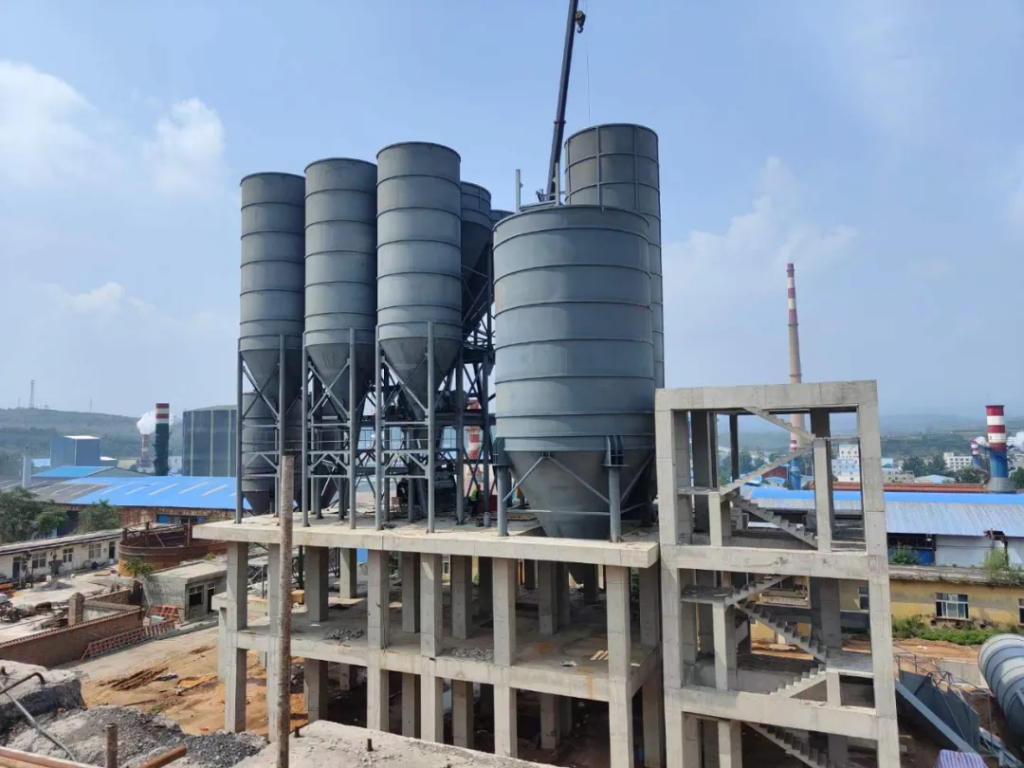1. Introduction to the Arching Phenomenon and Its Harm
The cement industry now mainly uses bulk cement. This is because bulk cement is more environmentally friendly and allows for accurate measurement. Modern cement silos do more than just store cement. They also provide dust removal, break arching, and weighing functions. However, arching inside these silos is a common and serious problem. This issue requires a good solution.
Arching happens when cement forms a stable bridge over the outlet. This bridge stops the cement from flowing out. This blockage causes major problems. First, it stops the supply of cement to the mixing station. This interrupts production and increases downtime. Second, it leads to uneven cement feeding. This directly harms the accuracy of the weighing and batching process.
2. Reasons for Arch Formation
Several factors work together to cause arching.
First, cement has internal cohesion and internal friction. These forces create shear strength. This strength makes the cement act like a solid block. It prevents particles from moving freely. So, the cement’s flowability becomes poor.
Second, external friction between the cement and the silo wall is important. A rough wall surface increases this friction. Also, a small cone angle at the bottom makes the problem worse. More friction makes arching more likely.
Third, outside air conditions affect cement. High humidity makes cement particles stick together. This increases cohesion and reduces flowability. Consequently, the cement becomes more solid and prone to arching.
Finally, the outlet size is critical. A small outlet reduces the flow channel for the cement. This smaller channel greatly increases the risk of forming a stable arch.

3. How to Prevent Arching in Cement Silos
We need a full-system plan to prevent arching. This plan must cover silo design, construction, and daily operation.
3.1 Use Side Discharge as an Effective Method
Choosing a silo with side discharge is a very effective design. This design creates a vertical wall at the discharge point. This wall reduces pressure above the outlet and breaks the “arch foot.” We can also use multiple or offset outlets. Adding too many outlets is not cost-effective and makes operation difficult.
3.2 Reduce Internal Friction
We must make the silo wall very smooth. A smooth wall helps the cement slide down easily. Steel plates make the best inner surface. However, for cost and heat transfer reasons, most silos use concrete. Concrete walls are rough. Therefore, we often line the hopper with steel plates or special cast stone. We can also paint the wall with smooth coatings like epoxy resin. These steps significantly reduce friction.
3.3 Control Moisture Entry
Cement easily absorbs water. The finer the cement, the more water it absorbs. After cement absorbs water, its particles hydrate. This makes them stick together and flow poorly. Then, the cement forms skins and arches. So, we must strictly control all moisture sources.
First, reduce the moisture content in the cement itself when it enters the silo.
Second, prevent any rainwater from leaking into the silo.
Third, and very importantly, stop moisture from the air compressor system.
3.4 Dry the Compressed Air
Compressing air reduces its volume. This also reduces its capacity to hold water vapor. Therefore, most moisture in the air turns into liquid water during compression. If this water enters the silo, it causes big problems. We must remove this moisture at all stages: compression, storage, distribution, and use. Dry air from the aeriation system is essential to prevent arching.
Air Compression: The operator must ensure the compressor’s coolers work well. They should check the outlet water temperature by hand regularly. The cooler tubes can crack and leak, so we must fix any issues immediately.
Air Storage: The air receiver tank collects water and oil. The operator must regularly open the drain valve at the bottom to remove this liquid.
Air Distribution: As air moves through pipes, it cools down further. More water condenses inside the pipes. So, we need drain valves on the pipelines and must use them daily.
Air Usage (Final Defense): We use two filters before air enters the silo. The first is a main-line filter filled with coke. The second is a tube-type filter on each branch line. Moist air enters this filter, and its tiny pores trap the water. The water then flows down to a drain valve. The operator must drain it regularly. Dry air then goes to the silo.
3.5 Increase the Cone Angle
We make the cone part steeper. The angle should be bigger than the cement’s friction angle against the wall (about 32°). A steeper angle, between 55° and 65°, reduces friction. But, a steeper cone makes the silo taller or reduces its capacity.
3.6 Enlarge the Outlet Diameter
A larger outlet diameter prevents a stable arch from forming. It is a direct and effective design solution.

